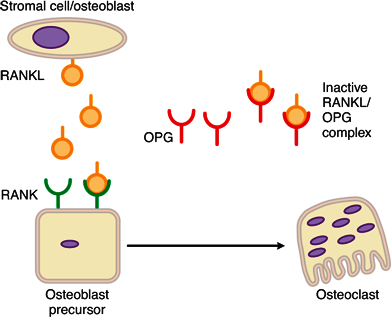Osteoprotegerin (OPG) is a protein that plays a central role in the regulation of bone mass. Also known as osteoclastogenesis inhibitory factor (OCIF), this naturally occurring protein [a soluble decoy receptor protein that belongs to the tumor necrosis factor (TNF) receptor superfamily] inhibits both the formation of osteoclasts (bone-resorbing cells) and the activity of these cells when they are mature. Because of this dual function, osteoprotegerin is believed to have great potential as a therapeutic agent for a number of bone and joint disorders, including rheumatoid arthritis, cancer-induced bone diseases, and osteoporosis (a metabolic condition in which decreases in bone mass and reductions in the amount of bone tissue increase the likelihood of fracture). In particular, because osteoprotegerin is able to block the development of osteoclasts, the administration of this protein is seen as a possible means to halt age-associated bone resorption and loss, to protect bone strength, and to decrease the chance of bone fracture. See also: Arthritis; Bone; Bone disorders; Cancer; Connective tissue; Joint disorders; Oncology; Osteoporosis; Protein

Throughout the lifetime of a human body, old bone is continually replaced by new bone. Specifically, old bone is broken down and then rebuilt in a process known as remodeling. Remodeling of bone requires the coordination of osteoclasts, which resorb bone, and osteoblasts, which are the cells that synthesize bone. The maintenance of proper bone mass is essential for the integrity of the skeleton, and it allows the replacement of old bone that has amassed microscopic fractures as a result of the physical stresses and strains placed on the skeleton during daily activities. Furthermore, the remodeling process allows for the body's metabolic demands for minerals to be met because bones are important reservoirs of key mineral ions, including calcium, magnesium, and phosphorus. Therefore, in theory, therapies that sustain the body's levels of osteoprotegerin should help to preserve bone health and the metabolic (mineral) processes associated with bone, especially in patients suffering from bone disorders and the elderly. See also: Aging; Calcium metabolism; Metabolic disorders; Phosphate metabolism; Skeletal system
Osteoprotegerin is also expressed in other types of cells and tissues, including the cardiovascular system and lymphocytes (T and B cells), where it may contribute to the phenomenon of apoptosis (programmed cell death). See also: Apoptosis
Notably, the female sex hormone estrogen has been found to slow the resorption of bone, primarily by stimulating the production of osteoprotegerin. This connection is especially critical in postmenopausal women, who experience declines in estrogen levels and thus have lower osteoprotegerin levels. Experimental investigations have shown that osteoprotegerin treatment impeded bone loss in estrogen-deficient animals. See also: Estrogen; Menopause





